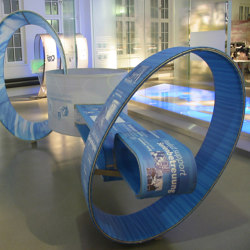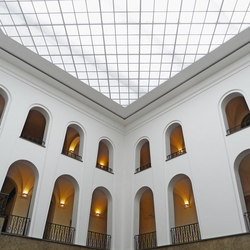Single-layer ETFE Roofs
Membrane roofing from Koch Membranen
Product description
Transparent construction with ETFE foils creates unique architectural possibilities. Not least because of their impressive environmental balance and cost-effectiveness compared to glass, constructions made of ETFE are increasingly in the focus of our architects.The high-quality ETFE fluoropolymer film with a unique combination of technical and physical properties, creates unique architectural possibilities. Facade and roof constructions benefit from low weight, maximum durability and outstanding self-cleaning properties. The films are highly transparent in visible and ultraviolet light spectra. Sun and heat radiation is regulated by imprinting, low-e coatings and the addition of colour pigments. ETFE films are installed as single-ply constructions or in cushion constructions. Our architects are increasingly focussing on ETFE constructions, not least due to the impressive environmental balance and the cost-effectiveness as compared to glass.
Concept
There are few areas where attractive design and efficient construction are as closely intertwined as in textile / membrane construction. Whether used for buildings that pose a challenge from an engineering standpoint or for flexible, temporary structures – lightweight constructions allow for an unlimited range of shapes and impressive structures boasting enormous span widths. The primary purpose of textile constructions is and always has been to provide the best possible protection against the weather. The best products in this category provide this protection in the most economical and ecological way - at minimum use of material and maximised reduction of weight.
Possible applications
No matter if they are used for rigid or for single or multi-layer textile structures in building shells, membrane materials set themselves apart by their unique design and technical characteristics. Prime examples of the material's versatility are mobile, collapsible membranes used to span stadiums or atriums or membranes used in classic tent or pavilion structures. As they can be shaped into any type of construction including sails, arched roofs, tents, umbrellas or pneumatic structures, membranes allow for a whole plethora of possible textile structures and designs.
Selection of materials
The created architecture owes its distinctive look and feel to the selected materials and their surfaces – whether the material is wide-arching fabric or pneumatic foil cushions. The material is always selected to fit each specific application perfectly. The decision on the appropriate material hinges on the design principles, the ambient and environmental conditions and such factors as light permeability, durability or cost. Other aspects influencing the decision include the handling, workmanship or force-stretch behaviour of the material. Finding and tailoring the material that is best for each specific construction project calls for a detailed and profound knowledge of the different materials. In contrast to glass construction, textile architecture has come to the fore for many planners thanks to its impressive environmental footprint and outstanding economy.
Materials suited for textile architecture
PVC-coated polyester fabric
PTFE fabric
PTFE-coated glass fabric
Silicone-coated glass fabric
ETFE foil
Custom-engineered special fabrics
Possible applications
No matter if they are used for rigid or for single or multi-layer textile structures in building shells, membrane materials set themselves apart by their unique design and technical characteristics. Prime examples of the material's versatility are mobile, collapsible membranes used to span stadiums or atriums or membranes used in classic tent or pavilion structures. As they can be shaped into any type of construction including sails, arched roofs, tents, umbrellas or pneumatic structures, membranes allow for a whole plethora of possible textile structures and designs.
Selection of materials
The created architecture owes its distinctive look and feel to the selected materials and their surfaces – whether the material is wide-arching fabric or pneumatic foil cushions. The material is always selected to fit each specific application perfectly. The decision on the appropriate material hinges on the design principles, the ambient and environmental conditions and such factors as light permeability, durability or cost. Other aspects influencing the decision include the handling, workmanship or force-stretch behaviour of the material. Finding and tailoring the material that is best for each specific construction project calls for a detailed and profound knowledge of the different materials. In contrast to glass construction, textile architecture has come to the fore for many planners thanks to its impressive environmental footprint and outstanding economy.
Materials suited for textile architecture
PVC-coated polyester fabric
PTFE fabric
PTFE-coated glass fabric
Silicone-coated glass fabric
ETFE foil
Custom-engineered special fabrics
More about this product
Part of the collection
Our Solutions For Outside.
Manufacturer
Koch Membranen
Family
Transpartent Constructions
Architonic ID
20178473
More products from Transpartent Constructions family
Related Projects
Contact information
Address
Nordstrasse 1, 83253 Rimsting/Chiemsee Germany
Get more information
Sign in to your Architonic account to have your contact details filled out automatically for each request.

More from
Koch MembranenContact information
Address
Nordstrasse 1, 83253 Rimsting/Chiemsee Germany


